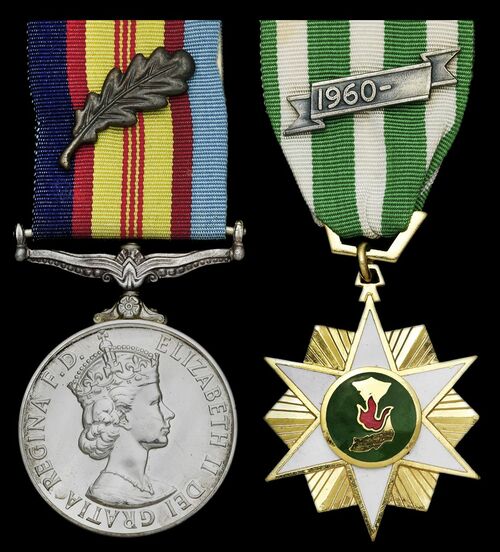
Auction: 23002 - Orders, Decorations and Medals
Lot: 69
The campaign pair awarded to Sergeant L. A. Elgar, Royal Australian Artillery, who was 'mentioned' for his part in the Battle of Coral
Vietnam 1964-73, with M.I.D. oak leaf (1410746 L. A. Elgir); South Vietnam Campaign Medal, 1 clasp, 1960 (1410746 L. A. Elgir) note surname spelling, good very fine (2)
M.I.D. London Gazette 10 December 1968.
Lindsay Arthur Elgar served as a member of the 102nd Field Battery and was awarded his M.I.D. for his actions at the Fire Support Base, Coral in May 1968.
102nd Field Battery and Battle of Coral
102nd Field Battery was raised in 1957 at Holsworthy as part of the 1st Field Regiment. The battery served in Malaya and in the Indonesian Confrontation before relieving the 106th Field Battery in Vietnam in March 1968. The parent unit of the 102nd Field Battery in Vietnam was the 12th Field Regiment. At the time, the 102nd Field Battery was equipped with American-made M2A2 105mm howitzers, which were older and heavier than the Italian-made L5 pack howitzers, that some Australian artillery units possessed, but were capable of prolonged periods of heavy firing.
Having begun operational service, the 102nd Field Battery initially acted as support for patrols in the Australian Tactical Area of Responsibility (TAOR). From April 1968, however, the battery mainly operated in direct support of the 1st Battalion, Royal Australian Regiment (1RAR). In early May 1968 the battery moved to Fire Support Base (FSB) Harrison, in coordination with 1 RAR's deployment into an area north of Saigon known as the "rocket belt".
The highpoint of the 102nd Field Battery's tour of duty was the battle of Coral. On 12 May 1968 the battery was flown in to FSB Coral with elements of 1 RAR and 3 RAR. Enemy forces in the area determined to attack the position as part of what became known as the Second Test offensive. The fly-in itself, moreover, did not go according to plan; it was marked by delays, confusion, and landing errors. As a result the defences at FSB Coral were not completed by nightfall.
At 1.45am the next morning a rocket and mortar bombardment on FSB Coral began. A fierce infantry assault followed, during which the enemy overran 1 RAR mortar positions and captured the 102nd Field Battery's No.6 gun. Sergeant John Stephens helped stabilise the situation by firing splintex anti-personnel rounds over open sights from the battery's No.4 gun. Accurate splintex fire from the 102nd Field Battery also prevented the enemy from dragging off one of the mortars from the positions they had captured.
As daybreak approached, the 102nd Field Battery fired more splintex rounds in support of 1 RAR infantrymen, who retook the positions lost the night before. Battery personnel also participated in a counter-attack that recaptured their No.6 gun, which the enemy attempted to disable. Harassed by artillery and air strikes, the enemy began withdrawing at around 6.30am, leaving 52 dead. Despite being heavily involved in the fighting, the 102nd Field Battery suffered surprisingly few casualties, with three wounded and none killed. The 12th Field Regiment headquarters, however, lost two men killed and three wounded.
Over the next weeks the enemy carried out more attacks on Australian positions in the area. Although FSB Coral was assaulted again, on 16 and 22 May, by this stage its perimeter defences had been straightened and reinforcements brought in, including Australian armoured units and an American artillery battery. During the attack of 16 May the enemy attempted to reduce the effectiveness of the 102nd Field Battery's defensive fire by pinning down the gunners with small-arms fire. The battery's positions were again a principal target for the enemy in this attack, which resulted in damage to two artillery pieces.
On 19 May the 102nd Field Battery provided supporting fire from FSB Coral for a battalion of the American 101st Airborne Division attempting to clear an enemy bunker system in the area. The battery fired more than 800 rounds over several hours in order to assist the Americans. The commanding officer of the American unit visited the battery positions three days later and complimented the gun crews on having done "a damned fine job". After the battle of Coral the 101st Airborne Division insisted on resupplying the 102nd Field Battery with both ammunition and beer.
Three members of the 102nd Field Battery were decorated for their part in the battle of Coral: Sergeant John Stevens received the Military Medal; Sergeant "Robbie" Robertson was awarded the British Empire Medal; and Sergeant "Algie" Elgar was Mentioned in Despatches.
The 102nd Field Battery returned to Phuoc Tuy province in early June 1968, and continued to provide fire support for Australian operations in Phuoc Tuy and Long Kahn provinces for the remainder of its time in Vietnam. In August 1968 forward observer Lieutenant Geoff Reed was wounded in intense street fighting between 1 RAR and enemy units in the town of Long Dien.
The 102nd Field Battery left Vietnam in February 1969, joining the 12th Field Regiment at Holsworthy. On its tour of duty the battery had occupied 30 different FSBs and fired 60,000 rounds; sold together with three copied photographs of Elgar in the field and assorted copied research confirming spelling of surname and regimental number as well as history relating to the unit.
Subject to 20% VAT on Buyer’s Premium. For more information please view Terms and Conditions for Buyers.
Sold for
£700
Starting price
£500




